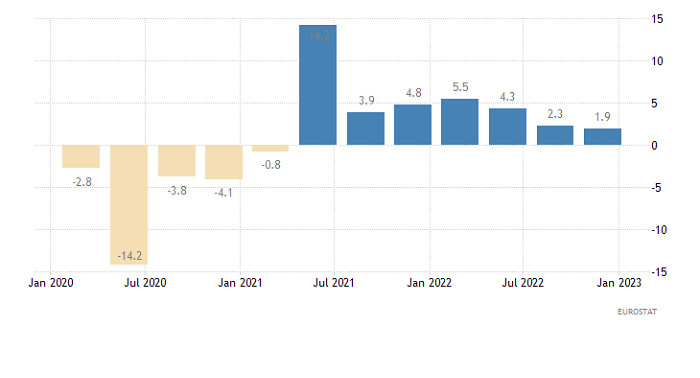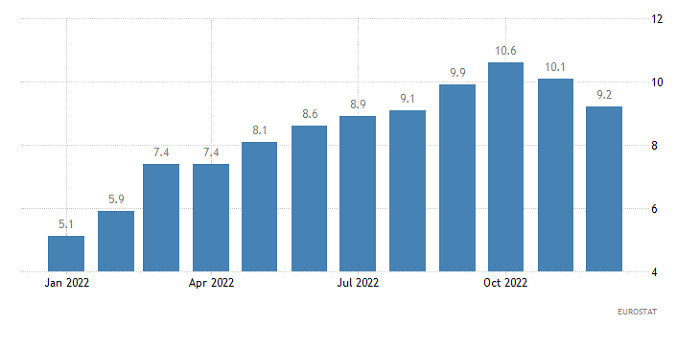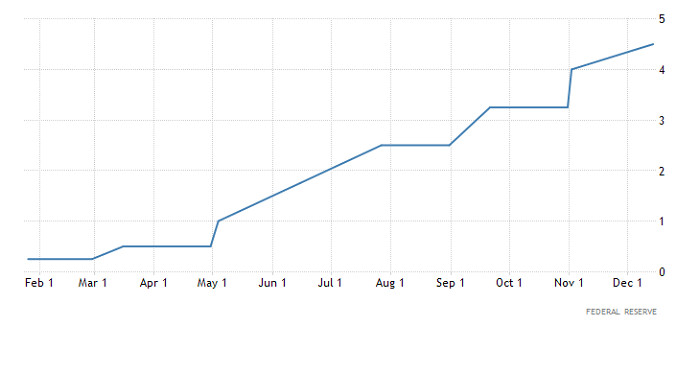
The euro dropped to the lower limit of the range just before the publication of the eurozone GDP data for the fourth quarter. After that, the currency started actively gaining in value. However, it has not reached the upper limit yet. Notably, the data slightly exceeded the forecast. Economists had expected a slowdown to 1.6% from 2.3%. However, the economic growth slackened to 1.9%. Although the indicator showed a slower rise, it should be compared to the same data from the US. Thus, the data on the eurozone GDP surpassed the forecast and twice exceeded the figures recorded in the US.
Eurozone GDP Growth Rate

Today, Europe will disclose its labor market data. Traders are unlikely to take into account the data since the unemployment rate is expected to remain unchanged. Meanwhile, the inflation report may unveil a slowdown to 8.7% from 9.2%. This means that the European Central Bank may start slackening the pace of the key rate hike and consider its cut. This, in turn, may have a negative effect on the euro. It is likely that traders will also ignore this report.
Eurozone Inflation

The fact is that today, all eyes will be turned to the FOMC meeting, the results of which will determine further events. Notably, a 25-basis-point rise is unlikely to affect the overall situation. Traders priced in such an outcome long ago. Closer attention will be paid to Jerome Powell's comments. If the Fed Chair announces that there will be no key rate cuts this year, traders' sentiment will change considerably and the euro will start rising confidently. Such a scenario is quite possible since Jerome Powell provided such comments at the end of the previous year. Thus, the euro has every chance to develop a long-lasting uptrend. If Jerome Powell changes his intention, investors will consider it to be a direct sign of the upcoming monetary policy loosening. In this case, the US dollar will resume falling.
US Key Interest Rate

The euro/dollar pair hit the support level of 1.0800. Thus, the flat movement turned into a full-scale correction. However, the situation has not changed considerably since the euro is still trading within the upward cycle.
On the four-hour chart, the RSI technical indicator returned to the mid line 50, which reflects a decline in the euro. On the daily chart, the indicator is still in the upper area despite the local price changes. This technical signal points to traders' intertest in rather long than short positions.
On the four-hour chart, the Alligator's MAs are providing mixed signals because of the recent flat and the correctional movements. On the daily chart, the indicator points to the upward cycle and the MAs are headed upwards.
Outlook
A decline in the volume of short positions near the level of 1.0800 led to a rebound. As a result, the euro started climbing, thus recouping losses.
From the technical point of view, the price consolidation above 1.0930 may lead to a prolongation of the uptrend. Meanwhile, a breakout of 1.0800 may spur a downward correction.
In terms of the complex indicator analysis, we see that in the short-term and intraday periods, indicators are providing buy signals because of the recent rebound from 1.0800. In the mid-term period, the indicators are ignoring the local changes in the price and pointing to the bullish sentiment.